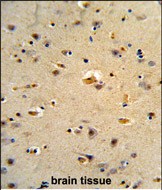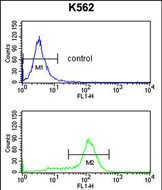CDK5RAP1 Antibody (C-term)
Affinity Purified Rabbit Polyclonal Antibody (Pab)
- SPECIFICATION
- CITATIONS
- PROTOCOLS
- BACKGROUND

Application
| FC, IHC-P, WB, E |
|---|---|
| Primary Accession | Q96SZ6 |
| Reactivity | Human |
| Host | Rabbit |
| Clonality | Polyclonal |
| Isotype | Rabbit IgG |
| Calculated MW | 67689 Da |
| Antigen Region | 544-571 aa |
| Gene ID | 51654 |
|---|---|
| Other Names | CDK5 regulatory subunit-associated protein 1, CDK5 activator-binding protein C42, CDK5RAP1, C20orf34 |
| Target/Specificity | This CDK5RAP1 antibody is generated from rabbits immunized with a KLH conjugated synthetic peptide between 544-571 amino acids from the C-terminal region of human CDK5RAP1. |
| Dilution | FC~~1:10~50 IHC-P~~1:50~100 WB~~1:1000 E~~Use at an assay dependent concentration. |
| Format | Purified polyclonal antibody supplied in PBS with 0.09% (W/V) sodium azide. This antibody is purified through a protein A column, followed by peptide affinity purification. |
| Storage | Maintain refrigerated at 2-8°C for up to 2 weeks. For long term storage store at -20°C in small aliquots to prevent freeze-thaw cycles. |
| Precautions | CDK5RAP1 Antibody (C-term) is for research use only and not for use in diagnostic or therapeutic procedures. |
| Name | CDK5RAP1 (HGNC:15880) |
|---|---|
| Synonyms | C20orf34 |
| Function | Methylthiotransferase that catalyzes the conversion of N6- (dimethylallyl)adenosine (i(6)A) to 2-methylthio-N6- (dimethylallyl)adenosine (ms(2)i(6)A) at position 37 (adjacent to the 3'-end of the anticodon) of four mitochondrial DNA-encoded tRNAs (Ser(UCN), Phe, Tyr and Trp) (PubMed:22422838, PubMed:25738458, PubMed:28981754). Essential for efficient and highly accurate protein translation by the ribosome (PubMed:22422838, PubMed:25738458, PubMed:28981754). Specifically inhibits CDK5 activation by CDK5R1 (PubMed:11882646). Essential for efficient mitochondrial protein synthesis and respiratory chain; shows pathological consequences in mitochondrial disease (PubMed:25738458). |
| Cellular Location | Mitochondrion. |
| Tissue Location | Expressed in heart, brain, placenta, lung, liver, skeletal muscle, kidney and pancreas (PubMed:10721722). Expressed in neurons of central nervous tissue (PubMed:10721722, PubMed:11882646) [Isoform 6]: High expression in placenta and lung. |

Thousands of laboratories across the world have published research that depended on the performance of antibodies from Abcepta to advance their research. Check out links to articles that cite our products in major peer-reviewed journals, organized by research category.
info@abcepta.com, and receive a free "I Love Antibodies" mug.
Provided below are standard protocols that you may find useful for product applications.
Background
Specifically inhibits CDK5 activation by CDK5R1.
References
Ching Y.-P., et.al., J. Biol. Chem. 277:15237-15240(2002).
If you have used an Abcepta product and would like to share how it has performed, please click on the "Submit Review" button and provide the requested information. Our staff will examine and post your review and contact you if needed.
If you have any additional inquiries please email technical services at tech@abcepta.com.













 Foundational characteristics of cancer include proliferation, angiogenesis, migration, evasion of apoptosis, and cellular immortality. Find key markers for these cellular processes and antibodies to detect them.
Foundational characteristics of cancer include proliferation, angiogenesis, migration, evasion of apoptosis, and cellular immortality. Find key markers for these cellular processes and antibodies to detect them. The SUMOplot™ Analysis Program predicts and scores sumoylation sites in your protein. SUMOylation is a post-translational modification involved in various cellular processes, such as nuclear-cytosolic transport, transcriptional regulation, apoptosis, protein stability, response to stress, and progression through the cell cycle.
The SUMOplot™ Analysis Program predicts and scores sumoylation sites in your protein. SUMOylation is a post-translational modification involved in various cellular processes, such as nuclear-cytosolic transport, transcriptional regulation, apoptosis, protein stability, response to stress, and progression through the cell cycle. The Autophagy Receptor Motif Plotter predicts and scores autophagy receptor binding sites in your protein. Identifying proteins connected to this pathway is critical to understanding the role of autophagy in physiological as well as pathological processes such as development, differentiation, neurodegenerative diseases, stress, infection, and cancer.
The Autophagy Receptor Motif Plotter predicts and scores autophagy receptor binding sites in your protein. Identifying proteins connected to this pathway is critical to understanding the role of autophagy in physiological as well as pathological processes such as development, differentiation, neurodegenerative diseases, stress, infection, and cancer.




